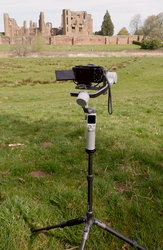I have been taking high-resolution panoramas for many years, and in recent years have been testing and using a number of motorised tripod heads for this. Please see the multi-row panoramas page for the reasons for using a motorised head along with details of ones I have used.
This page provides some background and information about the DJI RS4 Mini gimbal », together with Here are some additional resources:
- my checklist for using it which might prove a useful starting point for a new setup
- an analysis of the component weights of an example ‘kit’ using the DJI RS4 Mini
- and my setup notes that may help with initial balancing/setup.
The DJI RS4 Mini gimbal is developed and marketed by DJI. It is a well-specified pan-tilt-roll (3-axis) motorised gimbal with a good phone app for control. As well as being a very good gimbal for steadying cameras for stills and video, it can also be used as a motorised head for manual control and for high-resolution (multi-row) panoramas.
Compared to the other non-gimbal motorised heads I use, this is very light (873g, including attachment clamp plate and USB cable). It does, however, take up more room in a backpack than the others and requires some initial setup (balancing, which depends on the camera and lens being used and how they are mounted). Once set up it can be deployed rapidly if using the same camera and lens combination.
Using this gimbal, I have been able to a put together a complete panorama kit (details are here) that weighs under 3.0kg, including camera, lens, gimbal, tripod, and backpack. Since the gimbal is also a stabiliser a lighter tripod can be used than for fixed-movement heads.
DJI RS4 Mini gimbal
The DJI RS4 Mini gimbal (3-axis, 0.9kg) has been available since early 2025. It has a built-in touch-screen display for manual control as well as displaying battery level, etc. In addition, several physical controls, including a joystick, facilitate manual control.
The DJI Ronin app allows controlling the head from a smartphone with Virtual joystick (simple remote control), Time lapse, Panorama, and other options. Its Panorama option allows multi-row and repeat panoramas which are especially useful.
Compared to the DJI RS3 Mini it offers both auto-locking and auto-fold (activated when switching the gimbal on or off) with very little extra weight. These are very useful time-savers.
The gimbal can be attached directly to a tripod; I prefer to use a Leofoto 45mm QuickLink socket and plate to avoid having to rotate the head onto the tripod screw (and also allow quick testing on different tripods); this requires a spacer or rubber washer to attach the plate (with 3/8″ fitting) to the 1/4″ socket on the gimbal.
The gimbal comes with an Arca-Swiss-compatible clamp and plate which appear to be unique to DJI but (unlike the RS3 Mini) have the clamp grooves running usefully left↔right. The clamp also allows convenient fore-aft movement with an adjustment knob.
I have put together my lightest panorama kit based on the DJI RS4 Mini gimbal, a Sony ZV-E10 (or ZV-E10 II) camera, and the Sigma E-mount 60mm F2.8 lens. Together with a 4-section tripod, connectors, spare battery, etc., the kit weighs under 3.0kg (including backpack). Details are linked above.
The Sony ZV-E10 and ZV-E10 II have an articulated screen which allows using the tripod at a lower height for better stability; the tripod I use includes an extendable column. The Sigma E-mount 60mm lens is unusually light and sharp; for higher zooms I use the Sony 18–135mm zoom, which is about 150g heavier.
The gimbal connects to the camera via a USB-C to USB-C cable. The 2.5mm L1 shutter cable for Lumix cameras does not work with the RS4 Mini (although DJI say a replacement will be available in May 2025); Bluetooth can also be used with many cameras.
The pages and data here are for non-commercial use only. All content © Mike Cowlishaw, 1963, 2025. All rights reserved. Please see http://speleotrove.com/mfc/ » for contact details.
Privacy policy: the Speleotrove » website records no personal information and sets no ‘cookies’. However, statistics, etc. might be recorded by the web hosting service.
This page was last edited on 2025-07-04 by mfc.
